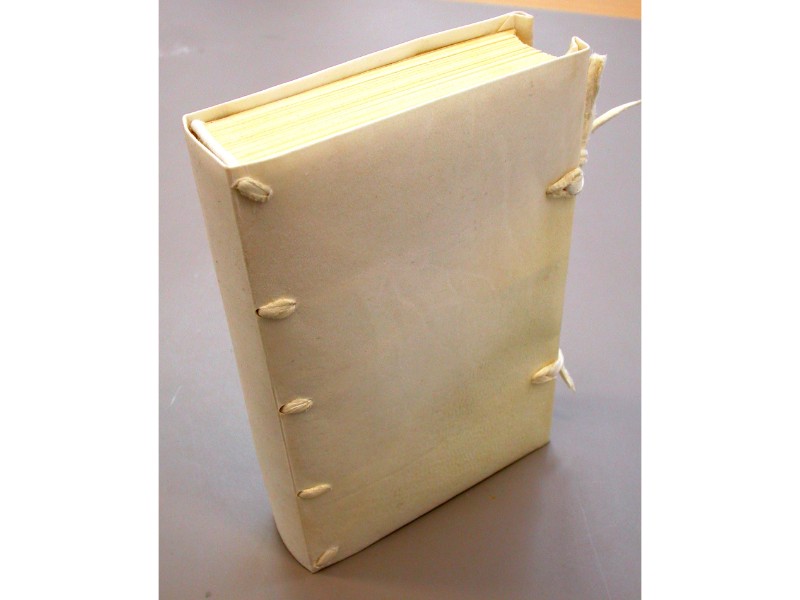
SG204B Program C
Introduction to Preservation and Preventive Conservation of Books
3 Units
Instructor: Prof. Francesco Maria Rizzo
COURSE STRUCTURE
Morning Work in the Terni Dioceses Archives: Monday – Friday, 8:30 AM – 1:30 PM;
Afternoon: Lectures and Workshop 3:00-7:00 PM
Course Description
No prerequisites required
This course gives a theoretical overview of the field of book preventive conservation and restoration of books and archival material along with some practical experience in non-invasive preventive conservation. Covers historical intrusive restoration. Students describe and assess conservation conditions of archival material from the Terni Diocese Archives and implement non-intrusive preventive conservation measures on original material in the Archives (dry cleaning, re-shelving, box making).
The program is aimed at two types of students: those planning to become book conservators, and people that in various ways will be managing book or archival resources. For those planning for a career as book conservators, this is a good introduction to the field that will require further education. For those planning to manage book collections or archives, it will offer skills in analyzing the nature of bound material, understanding the state of conservation, best practices in handling, storage and conservation.
Students of the following subjects can find this program useful: Bookbinding, book conservation and restoration, library science, library management, archival sciences, management of rare book collections, book design, anthropology and history of technology.
Course Objectives
To give students an overview of the field of conservation and restoration of books and archival material along with some practical experience in non-invasive preventive conservation.
Student Learning Outcomes: Students who successfully complete this course will be able to:
Handle correctly books and archival documents, using book cradles and supports
Analyze storage condition and be able to suggest improvements
Describe and identify the deterioration process of book bindings and contributing factors
Prepare documentation records for conservation assessment
Perform dry cleaning
Make archivally safe storage boxes and protections
Summary of Lecture Content
Deterioration processes of organic materials in bindings
External factors:
Temperature
Humidity
Light
Mechanical damage (handling, wear and tear)
Internal factors:
Natural deterioration process of organic materials
Chemical interaction between materials
Prevention and Minimal Conservation Methods
Biocides and decontamination
Deacidification
Climate control
Temperature
Humidity
Light
Shelving, flat file drawers and other storage units
Storage Containers
Drop back spine box
Phase box
Book shoe
Four flap folder
Housing of fragments and mounting of single sheets
Option on how to treat pamphlet, single sheet collections and miscellaneous
Handling procedures for rare and delicate books
Digitization and how to minimize risk from handling documents:
Minimizing damage during photographic processes
State of the art digitization,
Affordable alternatives
Conservation techniques
Proposing different treatment options and estimating times
“Fit for purpose”, different approaches to conservation treatments related to different contexts
Documentation record and what to record (data sheets/images before, during and after conservation)
In situ repairs
Full conservation treatment of bound item (hypothetical full treatment):
1. Dry cleaning
2. Checking foliation
3. Dismantling
4. Washing
5. Deacidification
6. Re-sizing
7. Re-constitution of the book block
8. Sewing (preparation of the sewing material and sewing frame)
9. New spine lining
10. New end bands like originals
11. Treatment of the cover
12. Re-application of original cover
Afternoon Workshops
Analyzing and documenting book bindings (working with books from the local archives):
Features to document
State of conservation
Data sheets
Photographic documentation
Prevention and Minimal Conservation Methods
Biocides and decontamination
Deacidifiaction
Climate control
Temperature
Humidity
Light
Shelving, flat file drawers and other storage units
Storage Containers
Box making:
Drop back spine box
Phase box
Book shoe
Four flap folder
Housing of fragments and mounting of single sheets
Digitization of archival material
Participate in process of photographing archival material from the San Gemini Historic Archives, as part of the San Gemini Archives Digitization Project.
Description of Assignments
Reading list supplied with acceptance to the program.
Term paper #1: 8- page paper on a topic to be assigned
Term paper #2: 8- page paper on a topic to be assigned (graduate students only)
Final exam: mixed format – quiz and essay questions
Grade Breakdown:
Term paper(s) 35%
Final Exam 35%
Archival storage-making and work 30%
Contact Hours
Lectures: 40
Workshops: 40
Grading scale:
94-100 = A 90-93 = A-
87-89 = B+ 84-86 = B
80-83 = B- 77-79 = C+
74-76 = C. 70-73 = C-
67-69 = D+. 64-66 = D
60-63 = D- Below 60 = F
















